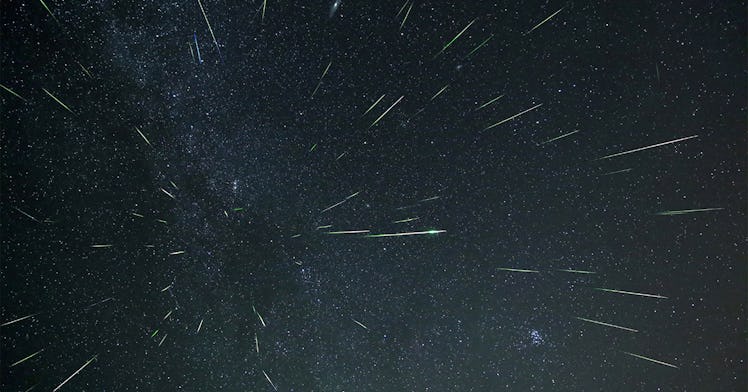The Draconid Meteor Shower Kicks Off An October Full Of Stars
Expect to see several meteors per hour.

When we look at the stars, it’s easy to be reminded of how much magic there is in the world. And, because most of us aren’t leaving the house too much these days, we might be looking for something to do — or a reminder of that magic. Luckily, this October gives us a magic show right in our own yards. The Draconid meteor shower kicks off tonight, on October 7, 2020. But October is going to be a month full of interesting happenings in the sky, and luckily, we’ve got all the details.
Where Can You See The Draconid Meteor Shower?
According to EarthSky, the Draconid meteor shower is set to peak on Oct. 7, 2020. However, it will still be visible in some areas on Oct. 8. The publication says the best time of day to watch the stars shoot through the sky is during the early evening hours or when the night falls, and it’s dark out.
The meteor shower will bring shooting stars across the sky, and EarthSky explains that the shower is created from a comet’s debris, specifically the 21P/Giacobini-Zinner comet. The publication explains that the name Draconid meteor comes from the shower appearing to be coming from the Draco the Dragon constellation direction.
The Draconid meteor shower isn’t the most spectacular. There is only expected to produce a few meteors per hour, but you’ll get the best view if you can watch in a dark, open, country sky. But the Draconid is also known for being pretty unpredictable — and over the past 100 years, there were 3 times where hundreds of meteors shot through the sky. So, it could be a huge jackpot for major stargazers.
CNN points out that people who live along the East Coast of North America will have the best view of the show. No special equipment is needed to see the stars shoot across the sky, so pull up a lawn chair for yourself and your kids and sit back and enjoy.
After the Draconid, Check Out The Orionids In Late October
Another type of meteor will be visible later this month when the Orionids start their star show, which is significantly larger than the Draconid showers. The Orionids bring 10 to 20 meteors shooting across the sky every hour. These tend to be visible later on in the night, usually after midnight and are best viewed in the very early hours before dawn.
“The Orionids sometimes produce bright fireballs, which can overcome some moonlight in years when the moon intrudes,” EarthSky reports. The peak time to see the Orionids is on Oct. 21 and 22, but some lucky stargazers may catch a few earlier in the week.
November will bring several meteor showers, including the South Taurids, North Taurids, and Leonids meteor showers.
This article was originally published on